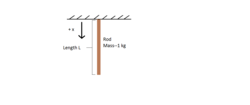Tension in the rod
 A rod of mass
1
k
g
is hanging vertically as shown, whose linear mass density varies according to the equation
λ
(
x
)
=
λ
o
sin
(
L
π
x
)
.
A rod of mass
1
k
g
is hanging vertically as shown, whose linear mass density varies according to the equation
λ
(
x
)
=
λ
o
sin
(
L
π
x
)
.
Find the tension(in newton) in the rod at x = 4 3 L .
Assumptions
- g = 9 . 8 s 2 m
- x is measured from the high end to the low end of the rod.
The answer is 1.435176772.
This section requires Javascript.
You are seeing this because something didn't load right. We suggest you, (a) try
refreshing the page, (b) enabling javascript if it is disabled on your browser and,
finally, (c)
loading the
non-javascript version of this page
. We're sorry about the hassle.
2 solutions
Exactly the same steps I followed to arrive at that.
i got 1.47 :/
I think λ o = 2 M should be the right relation.
It is not in class 11 syllabus
In order to find the tension, we must equate the gravity acting on the rod below a point:
T ( ℓ ) = ∫ ℓ L g λ ( x ) d x = g λ 0 ∫ ℓ L sin ( L π x ) d x = g λ 0 ( − cos ( π ) + cos ( L π ℓ ) )
So now we need to find λ 0 . We know that:
m = ∫ 0 L λ 0 sin ( L π x ) d x ⇒ λ 0 = 2 L π
Thus we have:
T ( 4 3 L ) = 2 L g π ( 1 + cos ( 4 3 π ) ) = 1 . 4 2 5 1 7 6 7 7 2 N
First, lets find λ o
We know, M = ∫ 0 L λ ( x ) d x
So, M = ∫ 0 L λ o sin ( L π x ) d x
→ M = π 2 L λ o
→ λ o = 2 L M π
According to the question, M = 1 k g . So,
λ o = 2 L π
Now that we know λ o , we will equate the force due to the part of the rope that is below x = 4 3 L to the tension.
The force due to that part of the rope will be the mass of that part times g .
So,
T = g ∫ 4 3 L L λ ( x ) d x
= 2 2 g ( 2 − 1 ) ≈ 1 . 4 3 5